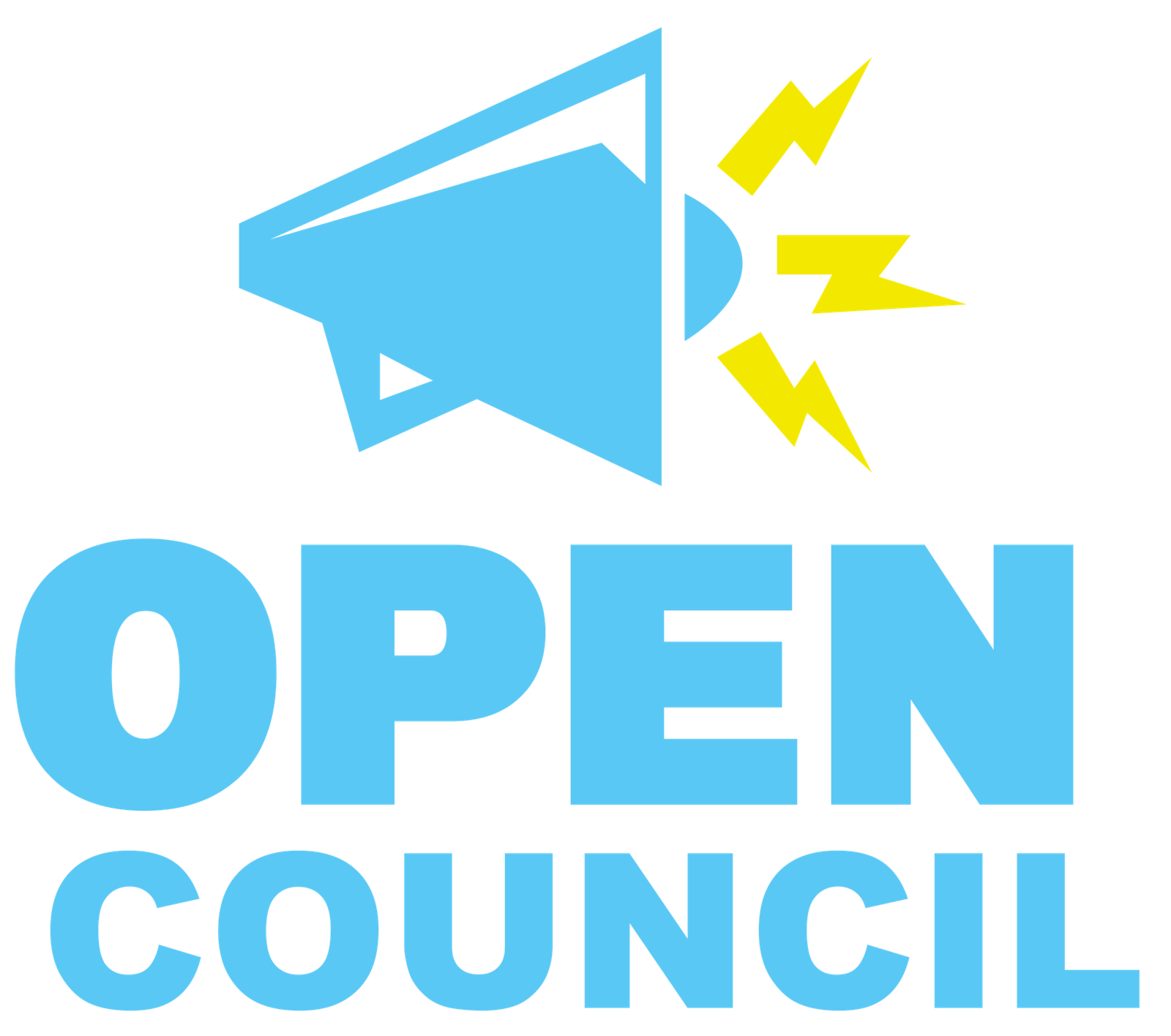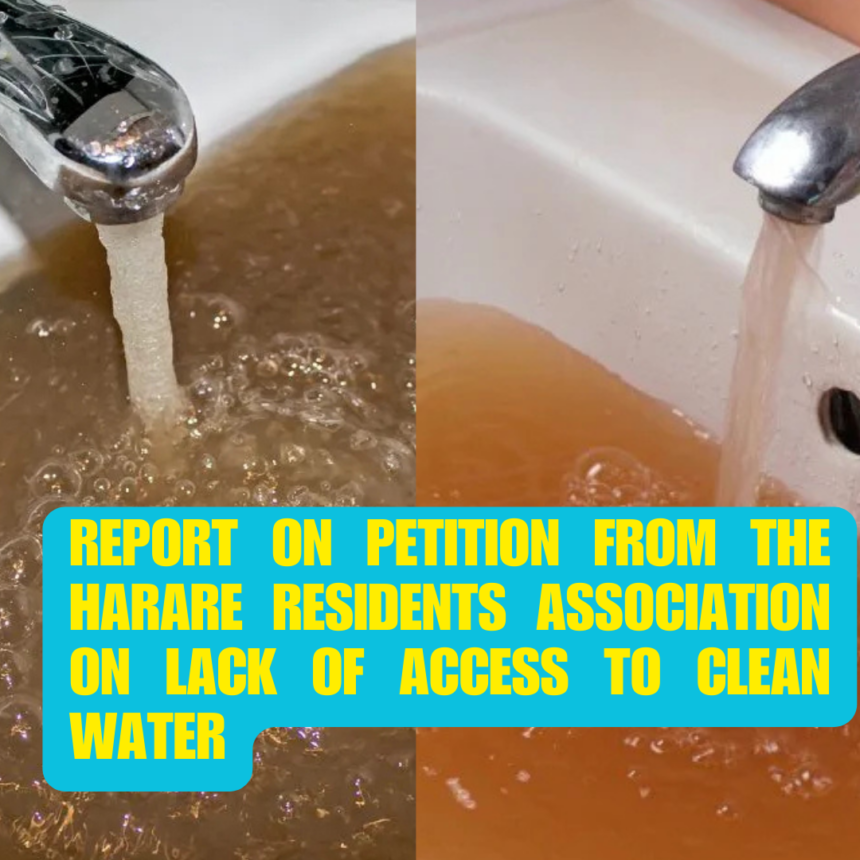HON. TSHUMA J: Thank you Madam Speaker. According to Section 149 of the Constitution, read together with Standing Order No. 191 and Appendix E of the Standing Rules and Orders, every citizen and permanent resident of Zimbabwe has a right to petition Parliament to consider any matter within its authority, including the enactment, amendment or repeal of legislation. To this end, the Committee received a Petition from the Combined Harare Residents Association beseeching Parliament to consider the challenge of clean water supply in Glenview and in Greater Harare. In terms of its mandate, the Committee resolved to conduct an inquiry on the matters raised in the petition.
The objectives of the Committee in conducting the inquiry were:
- To assess the water supply and treatment capacity of the City of Harare;
- To have an appreciation of the current efforts being implemented to address the adequate supply of water to residents of Harare;
- To have an understanding of the challenges affecting water supply and water treatment in Harare, and
- To come up with appropriate recommendations for addressing the water supply and water quality challenges faced by the Harare City Council.
The Committee received oral evidence from the following stakeholders:
a) Combined Harare Residents Association,
b) Harare City Council,
c) Upper Manyame Sub-Catchment Council (UMSCC),
d) The Environmental Management Agency (EMA),
e) The Ministry of Lands, Agriculture, Water, Fisheries and Rural Resettlement and,
f) The Ministry of Local Government and Public Works.
The Committee further conducted familiarisation visits to Morton Jeffrey Water Works, Prince Edward Water Treatment Plant and to Kunzvi and Muchekeranwa Dams from 11 – 12 July 2024. The oral evidence received from the different stakeholders and the familiarisation visits provided the Committee with enough information to come up with a comprehensive report on the issues raised by the Combined Harare Residents Association.
Status of Water Rationing and Management.
The Committee gathered that Harare Water Works had the responsibility of supplying water to Harare, Chitungwiza, Ruwa, Epworth, Norton, and Inkomo Barracks. The Committee noted that western suburbs (Glenview, Glen Norah, Southerton, Kambuzuma) have 5 days of water supply per week that is Monday to Friday, while eastern suburbs (Ruwa, Epworth, Tafara, Mabvuku) have water during weekends. The northern suburbs (Mt-Pleasant, Dzivarasekwa, Marlborough, Bluff-hill) have water from Monday to Thursday, while the CBD and the industry were exempted from the water demand
management schedule. The Committee found out that the western areas were getting more water compared to other places because of their susceptibility to waterborne diseases which usually stems from the consumption of water from untreated sources such as boreholes and wells. Glen View, the area referred to by the petitioner was getting water from Monday at 1000hrs to Wednesday at 1800hrs, then from Thursday 0800hrs to Friday 1600hrs as per the Harare Water Demand Management schedule. The demand management schedule was being implemented to govern the limited supply of water in Harare.
Status of Harare Sewer Municipal Treatment Infrastructure.
Through engagement with the Environmental Management Agency (EMA), the Committee gathered that there was a continued discharge of raw sewage into the environment by Harare City Council which was primarily caused by malfunctioning water treatment plants and sewer pipe collapses at Firle and Crowborough. Furthermore, the sewer management system in Harare was further compounded by the partial operation of the 6 sewerage treatment plants due to power cuts and dilapidated infrastructure. EMA further expounded that the impact of
raw and partially treated sewerage discharge had been tremendous on groundwater, with research findings pointing to 43% of boreholes in Harare being contaminated by sewerage and faecal matter. This discharge of raw and partially treated sewage into the environment had increased water treatment costs for the City of Harare, which was now using nine chemicals to treat drinking water at a cost of US$0.22 cents per 1000 litres. This increased cost of water treatment places Harare in a vicious cycle of battling waterborne diseases such as cholera and typhoid.
CURRENT EFFORTS TO ADDRESS WATER ISSUES.
Short to Medium Term Plans.
The US$7.4million Water augmentation Project Financed by Treasury. To address water access issues, the City of Harare had targeted a water production level of 520 mega litres per day by 31 December 2024. In order to reach that target, the city required a total of US$7,479, 980, 00 in capital works. This initiative was born out of City of Harare engagements with the Ministry of Local Government and Public Works and the Ministry of Finance, Economic Development and
Investment Promotion for the disbursement of the funds in three phases to cover the US$7,4 million capital fund. However, to date, the city has not received the funding.
Phase 1: The first phase required US$ 1,313,470, which was supposed to be disbursed by 30 March 2024. This allocation was expected to cover the isolation of Darwendale intake works, the initial works on clarifiers, filters and the initial payments for the replacement of pumps 7 to 10 and Letombo pump station among other works necessary to prepare for phase 2. Phase 1 accounted for 18% of the total project cost.
Phase 2: The second phase of the project required a disbursement of US$2,390,640 by June 30, 2024. This was mainly the cost of rehabilitating clarifiers at Morton Jeffrey Water Works, supply of filter sand and the rehabilitation of the chemical dosing plant. It was further indicated that the rehabilitation of Letombo pump station would also require a 40% disbursement during this phase. Phase 2 accounted for 32% of the total project cost.
Phase 3: The third phase of the project required a disbursement of US$ 3,775,870 by the 30th of September 2024. This allocation was earmarked for the rehabilitation of filters at Morton Jeffrey. This phase accounted for 50% of the total project cost. The city further highlighted that the submissions for the first phase of the project were made to Treasury and the City still awaits the disbursement of the same.
Muchekeranwa Pipeline Project.
The Committee gathered that the Government had embarked on the construction of the Muchekeranwa pipeline project to alleviate Harare’s water shortage by transferring bulk raw water from Muchekeranwa Dam to Wenimbi Dam and finally to Seke dam near the Prince Edwards Water Treatment Plant. This temporary initiative is crucial amidst the city’s water crisis. The project plans to construct three booster pump stations and a 26km, 600mm diameter pipeline to Wenimbi Dam, with the first pump house currently under construction. The clearing and marking of the pipeline route have been completed, and trenching will commence once the pipes are in place.
It was noted that a further 23km pipeline was needed to connect Wenimbi Dam to the Manyame tributary, enabling natural water flow to Seke Dam for treatment at the nearby Prince Edward Water Treatment Plant. The project was budgeted at US$19 million and fully funded by the government. The project had so far received only US$2.4 million (12.5%), sufficient for completing 4.5km of the pipeline. It was further gathered that the supplier Makomo Engineering had already purchased the pipes for the pipeline and was awaiting the delivery of the consignment from a South African supplier.
The project’s goal is to supply 30 mega litres per day from Muchekeranwa to Wenimbi during the dry season, enabling the Prince Edward Plant to operate at its full capacity of 90 mega litres per day. However, delays in treasury disbursements are impeding the progress, threatening the project’s timely completion. The Muchekeranwa pipeline project holds promise as a critical interim solution for Harare’s water supply challenges.
Long Term Solution
The Kunzvi –Musamhi project: The Committee gathered that; the Government has earmarked the Kunzvi Musamhi project to provide adequate water supply to all areas in Harare. The water infrastructure project is divided into two phases: Phase 1 includes the construction of Kunzvi Dam, the Kunzvi-Harare Water Treatment Plant, and the Kunzvi-Harare Pipeline. Phase 2 involves building Musami Dam and then integrating it into the Kunzvi water supply system. The estimated cost of the project is broken down as follows: Kunzvi dam (US$108m), Kunzvi Water Treatment Plant (USD53m), the Kunzvi-Harare Pipeline (USD51m) and the Musami dam is estimated at US$200m. Once completed, the project will not only benefit the City of Harare but also surrounding communities, including Village Business Units (VBUs) in Goromonzi and Murehwa.
The Kunzvi Water Treatment Plant is expected to produce 235 mega litres per day. When combined with Musamhi Dam, the total output will be 498 mega litres per day. The treated water will be transported through the 33 km Kunzvi-Harare pipeline to the New Donnybrooke Reservoir and then pumped to Old Donnybrooke and
Greendale Reservoirs respectively. The project aims to supply water to areas such as Calidonia, Sally Mugabe Heights, Crowhill, Shamva and Mutoko road households. However, the construction of the dams necessitates the need for the reorganisation of some families affected by the project. The Ministry of Lands, Agriculture, Water, Fisheries, and Rural Resettlement, along with the Ministry of Local Government and Public Works, were collaborating to ensure that the affected families are resettled appropriately. The families are expected to be incorporated into farms within their respective districts. This comprehensive approach aims to mitigate the negative impact of the project on local communities while enhancing water supply infrastructure for the region.
None-punitive efforts by EMA to regulate Harare City Council. The Committee gathered that EMA had served Harare City Council with 20 orders, handed over 50 tickets, brought the city to court twice and summoned the city to appear before the Environmental Management Board twice. Despite all these approaches, the pollution and environmental damage caused by the city has continued unabated. The Committee observed that these punitive efforts were not addressing the
challenge of water pollution, as the council was finding it cheaper to pay fines than adhering to environmental regulations. Measures that are more stringent are needed to decisively address the scourge of pollution by the City of Harare.
Construction on wetlands.
The incessant and rampant construction on wetlands across Harare was seemingly increasing in the presence of the City of Harare and regulators such as EMA. This was in turn preventing natural water seepage and the filtration process of raw sewer deposited into the environment. The Committee observed that despite the existence of the 2021 Wetland Master Plan and the gazetted strategic wetlands, the encroachment and proliferation on wetlands has continued thereby amplifying the dire water quality issues in Harare.
Nature of the relationship between Upper Manyame Sub-Catchment Council, EMA and ZINWA.
The petitioner had raised concern over the uncomplimentary relationship between the Harare City Council, Upper Manyame Sub-Catchment Council, EMA and ZINWA concerning the management of
water resources in Harare. However, through the protracted and rigorous engagements with the agencies, the Committee concluded that the relationship between the three entities was complementary even though more could be done in as far as data sharing and cooperation is concerned. This gap in data sharing was creating a challenge in the governance of gazetted wetlands and the management of ever sprouting un-regularised settlements.
Obsolete infrastructure at water treatment plants. The Committee identified significant challenges at the Prince Edward and Morton Jaffrey Water Treatment Plants. The Morton Jaffrey Plant, with a capacity of 704 ml/day, falls short of the daily demand of 800 mega litres required by the city. The demand for water for greater Harare will rise to 1200 mega litres per day once un-serviced areas are connected to the system. The Committee was alarmed that repairs and maintenance had reduced the water treatment capacity at Morton Jeffrey to 454 ml/day, with actual production at 320ml/day due to financial constraints affecting chemical procurement. The Committee also noted that the Morton Jeffrey Plant was designed to expand at a 20-year interval but
the last expansion of the treatment plant was in 1994, representing a 30-year time lag without expansion. Raw water at Lake Chivero was being polluted by raw sewage from Chitungwiza Municipality which does not have a single sewer treatment plant. This excessive pollution was placing the city in a perpetual, rehabilitation exercise of intake valves and other infrastructure repairs. Illegal mining activities were another factor threatening the Chivero tunnel and vandalism had also affected the Manyame intake works and Darwendale pump station, with both needing significant upgrades.
The Prince Edward Water Treatment Plant, with a capacity of 90 ml/day, operates below capacity with only one operational water pump out of a total of four. It provides water to Chitungwiza, Robert Mugabe International Airport, Hatfield, Waterfalls and Letombo flats. It was further noted that the silted Seke Dam now only supports the plant for 6 to 8 months a year. In addition, the outdated clarifiers increased backwashing frequency, and financial constraints inhibited modern equipment procurement. The rehabilitation of the Morton Jeffrey Water Treatment Plant was estimated at US$22million.
Idle waste water treatment infrastructure at Morton Jeffrey. The Committee also found out that the Odyssey Wastewater Treatment Plant which was built through the help of the Government of Israel at Morton Jeffrey Water Treatment Plant, has been lying idle and has never operated since its installation in 1996. It has the capacity to augment water supplies by 40 mega litres per day. The unused plant represents a significant amount of sunk capital expenditure while at the same time providing the potential of significantly contributing to the treated water output through the wastewater to portable water model.
Funding gaps to complete pump station rehabilitation. The US$7.4 million finance package intended to upgrade the Morton Jeffrey Water Treatment Plant by increasing its capacity from 320 ml/day to 520 ml/day, had not been disbursed by Treasury. Despite proposals and an agreement on a three-phased funding model, Treasury made no disbursements towards the project. This lack of funding has limited the plant’s capacity to 320 ml/day, an output that is significantly below the total demand of 750-800 ml/day.
Diminishing water level at Prince Edward Pump Station. The Committee found out that the city faced an impending crisis with its raw water supply. Information gathered in July 2024 indicated that the Prince Edward Water Treatment Plant was scheduled for decommissioning in August 2024 due to inadequate raw water supply from Seke and Manyame Dams. This decommissioning would result in a significant shortfall in water supply for areas that include Hatfield, Chitungwiza, Robert Gabriel Mugabe International Airport, and Waterfalls.
Raw Water Quality Issues.
Lake Chivero’s raw water supply is severely polluted due to direct sewage effluent entering the lake, coming from Chitungwiza Town Council, along with illegal fishing nets which also cause frequent breakdowns of the intake valves. Similarly, Darwendale Dam is affected by raw sewage effluent from Norton Town Council. These pollution sources require intensified chemical treatment of the water, leading to increased production costs.
Non-revenue water losses.
Of the 320 mega litres produced per day at Morton Jeffery Water Treatment Plant, 60% is lost due to dilapidated infrastructure, aged metering and illegal connections. Some meters have been in use for over 40 years, contributing to these losses. The city faces significant challenges in accessing critical infrastructure development, exacerbated by an urgent need to upgrade its 5,800km water distribution network and new meters installation, requiring an estimated US$3.3 billion investment. Aging infrastructure coupled with inadequate maintenance has led to high levels of water losses within the city. Budgetary constraints have further hampered planned maintenance activities for the water treatment plants, bulk water infrastructure and reticulation pipelines.
Expensive water treatment chemicals and debt. The City of Harare faces significant challenges in securing water treatment chemicals, exacerbated by severe pollution from sewage. The treatment process currently requires nine different chemicals due to high contamination levels. For instance, Morton Jeffrey Water Works alone consumes eight tonnes of activated carbon at full capacity per day, placing a substantial
strain on the City’s finances. Presently, Harare is burdened with a US$3 million debt owed to CHEMPLEX Corporation, its domestic chemical supplier. The restructuring plan demands daily payments of US$50,000. Crucially, essential chemicals like chlorine must be imported from South Africa. However, accessing foreign currency through the Reserve Bank of Zimbabwe’s forex system has proven to be a major obstacle, severely hampering the procurement of these vital supplies.
Non-payment of water rates by Government, commercial and domestic users.
As of July 2024, the City of Harare was owed a debt totalling ZWG 70 million owed by Government, industry and domestic. This outstanding amount severely affected the City’s ability to procure essential chemicals and conduct necessary repairs and maintenance at its water treatment plants. Of this total, ZWG43 million was owed by various Government entities, with ZWG19 million specifically owed by the Ministry of Defence. The remaining ZWG27 million was owed by commercial and domestic users. These unpaid debts have further
exacerbated Harare’s water supply challenges, intensifying the city’s ongoing water issues.
The Committee observed that Harare City Council faces significant challenges in providing safe and clean water to its residents, particularly due to rapid urban expansion and unregulated settlements in areas such as Harare South, Caledonia Farm, some parts of Budiriro and Churu among other areas. These sprouting settlements often lack proper infrastructure and planning, leading to difficulties in ensuring consistent water supply and sanitation services. Additionally, the City’s water infrastructure is strained by the expanding neighbouring towns of Norton, Chitungwiza, Ruwa, and Epworth, which rely on Harare for their water supply. The Committee gathered that the growing population in these areas was increasing the demand for water, putting further pressure on Harare’s ageing and inadequate water treatment and distribution systems. Consequently, the city struggles to maintain water quality and availability, posing health risks to its residents.
The Committee observed that the struggles faced by the local authority (HCC) in addressing water pollution issues were primarily due
to financial challenges. The Committee further observed that EMA was acting only as a regulator and enforcer handing out punitive fines. Instead, EMA should provide a solution in accordance with the Environmental Management Act which speaks to the use of the Environment Fund. The Fund is funded by the carbon tax of US$0.03 cents per litre of petroleum and diesel, or 5% of the cost, insurance and freight value, whichever is greater as defined by the Customs and Excise Act (23.02) to protect and maintain the environment. Although the provisions of the EMA Act provide for the collection of carbon taxes, the Environment Fund in which the tax revenue is to be consolidated, was non-existent. The Fund has the capacity to raise US$$55 million annually. This impasse, which the Committee observed, was short-circuiting the role of EMA in implementing non-punitive efforts in augmenting effluent and solid waste management in Harare.
The Committee observed that Treasury’s delay in disbursing the US$7.4 million capital injection into the Harare Water Augmentation
Project was undermining the City’s efforts towards addressing its water supply problem.
The Committee observed that delays in releasing funding for the Muchekeranwa pipeline project was stalling the progress of completing the project by December 2024 as per its planned timeline of completion. The Committee observed that Harare City Council debts owed to chemical supply companies were affecting the operational capacity of Harare water treatment plants particularly the Morton Jeffrey which consumes 4 tonnes of chemicals (black carbon) per day.
The Committee observed that the government debt of ZWG43 million to Harare City Council for water rates was too much and grossly undermines the City’s financial capacity to pay its dues to chemical suppliers. The Committee observed that the lack of sewer treatment plants in Chitungwiza and the direct discharge of raw sewer to Lake Chivero one of Harare’s water supply dams was exacerbating the recurrent threat of typhoid and cholera in Harare. The Committee observed that there is lack of private players in the water supply and
management value chain to provide financial assistance to Harare to augment its water supply network and the non-commercial water losses.
The Committee furthermore observed that there is a disjuncture in the laws that govern water resources. The laws such as the EMA Act and the Water Act need amendment and alignment to allow for data sharing and a synchronised approach in environmental protection and water resources management.
Recommendations
The Ministry of Finance, Investment Promotion and Economic Development must release the USD7.4million capital injection in its entirety towards the Harare Water augmentation Project by 31 March 2025. The City of Harare Councillors must consider and adopt a private sector engagement model to finance to modernise the water billing system by 30 June 2025. The Ministry of Local Government, Public Works must conduct a pilot study into the implementation of the prepaid water system implementation by 30 May 2025. The Ministry of Finance, Economic Development and Investments Promotion must pay the ZWG 43 million owed by the Government to HCC for water rates
directly to the City of Harare water chemical suppliers by 31 March 2025.
The Ministry of Finance and Investment Promotion must ensure the timeous disbursement of the USD19 million allocated for the Muchekeranwa-Wenimbi Pipeline by 31 March 2025 to ensure its completion by the scheduled deadline. The Ministry of Local Government and Public Works and the City of Harare must consider transforming Harare Water Works into a semi-autonomous public entity, jointly managed by the Harare City Council, the Government, and private sector stakeholders by 30 June 2025. The Ministry of Finance, Economic Development and Investment Promotion must disburse the carbon tax funds to EMA by 30 June 2025 as per the provisions of the EMA Act.
The Ministry of Local Government and Public Works must ensure that the feasibility studies on the Odyssey waste-water treatment facility at Morton Jeffrey and the recapitalisation of sewer treatment infrastructure for Chitungwiza Municipality are completed by 31 September 2025. The Harare City Council must ensure that levies and
rates for effluent and solid waste management are ring-fenced as per the guidelines of the Call-to-Action blueprint by 30 March 2025. The Ministry of Local Government and Public Works and the Ministry of Lands, Agriculture, Water, Fisheries and Rural Development must ensure that amendments to the Water Act 20:24 and all necessary alignments are done by 31 December 2025. The Ministry of Local Government and Public Works must ensure that the finalisation of the Local Authority Master Plan by the City of Harare is concluded by 30 April 2025 as per the dictates of the 2024 Call to Action Blueprint.
The Committee appreciates the effort of the Harare Combined Residents Association to raise the need to address the behemoth of water supply that has laid siege to Harare for decades. The imperative for addressing Harare’s water supply challenges with deliberate and focused efforts cannot be overstated. As a capital City and epicentre of all commercial activity, Harare plays a pivotal role in advancing the National Development Strategy 1 (NDS1) and achieving Vision 2030’s goal of attaining an upper middle-income status. Tackling the longstanding issues of sewer treatment and access to clean water is long
overdue. The implementation of these recommendations by the Committee must be met with a coordinated response from stakeholders, including government and relevant stakeholders. Together, we can catalyse a transformation that revitalizes Harare City Council into a beacon of progress and prosperity, embodying the true essence of an upper middle-income society by 2030. I Thank You.



